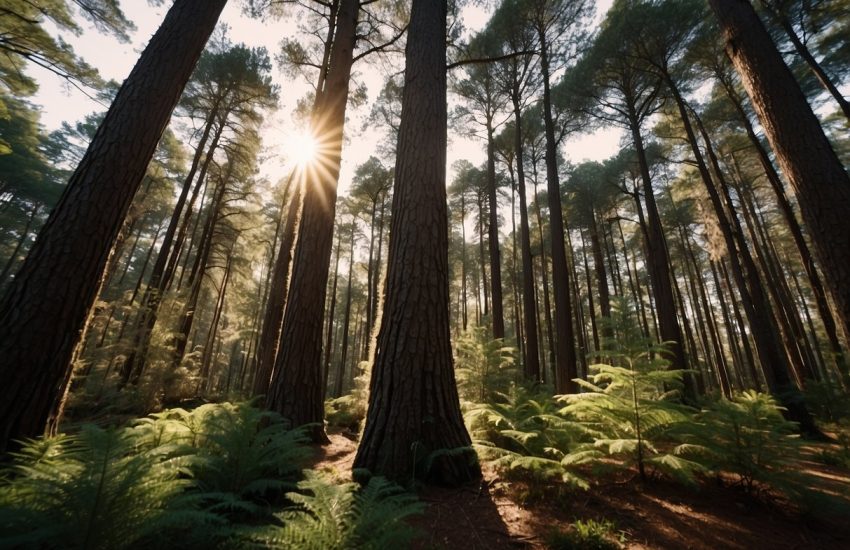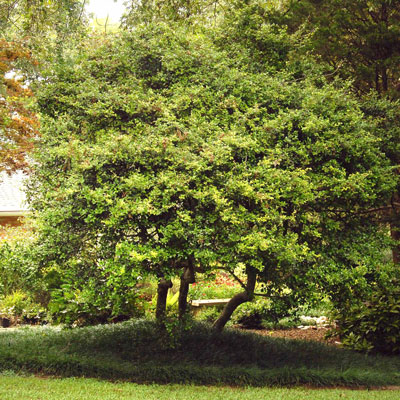The Best Evergreen Trees to Grow in Colorado
When they think of Colorado, most people envision snow-covered mountains and mountainsides covered in evergreen trees. Although they may appear the same from a distance, the Rocky Mountains are home to various natural evergreen plants. While trees make up the majority, evergreen plants can grow as shrubs. Because they maintain their green foliage all year long, they are known as evergreens.
15 Evergreen Trees to Grow in Colorado
1. Alberta Spruce
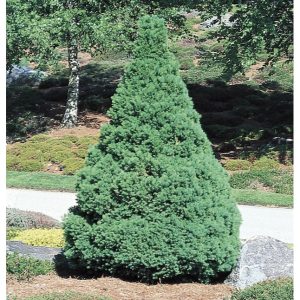
A coniferous evergreen with a traditional pyramidal shape is the Alberta spruce. This dwarf variety develops slowly, gaining only 2-4 inches yearly. The 2-4 inch long needles have a pleasant scent. The Alberta Spruce grows densely and thrives in exposures to the north or east. The Alberta Spruce thrives in climates with chilly winters and coolish summers. Plant in acidic, wet, well-drained soil.
Although it can handle some shadow because of its dense foliage, it's preferable to place it where there is sufficient air circulation to prevent difficulties in the future.
2. Austrian Pine
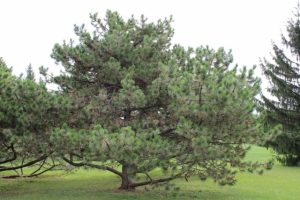
The Austrian Pine is a resilient tree that can survive the harsh conditions of urban areas, such as heat, drought, and air pollution. The dark green, somewhat twisted needles come in bundles of two. They grow to a length of 3-6 inches and remain on the tree for 4 to 8 years, giving it a dense crown. With rises of 13 to 24 inches each year, the Austrian Pine has a modest to medium growth rate.
Alkaline, acidic, sandy, well-drained clay soils will support the growth of Austrian pine trees. It will endure some drought conditions, though it prefers moderate moisture levels. It forms an oval as it develops and is effective as a windbreak. Birds and squirrels enjoy the seeds, and owls choose the tree for nesting and protection.
3. Colorado Bristlecone Pine
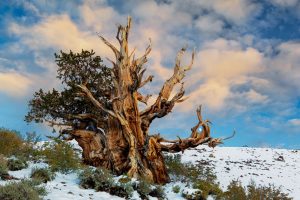
The Colorado Bristlecone Pine is one of the numerous pine trees native to CO and may be found in the southern Rocky Mountains. It has a rounded, flattened uneven crown and a steeply tapering and twisting trunk.
The young, twisted branches resemble long bottlebrushes, and the bark ranges from gray to reddish-brown. The leaves have a deep blue-green tint, 5 per bundle, upcurved, and last 10–17 years. The Colorado Bristlecone Pine's seed cone matures during two years. The subalpine to montane regions of Colorado, New Mexico, and Arizona are where you can find Colorado Bristlecone Pines in the wild.
4. Douglas Fir
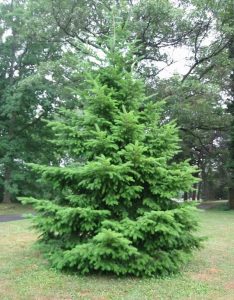
Conical-shaped and endemic to North America, the Douglas Fir grows quickly. It can thrive in a variety of soil types and can withstand cold temperatures very well. The mouse-tail-shaped bracts encircle the 3- to 4-inch-long cones of the Douglas Fir are called bracts.
Douglas fir typically grows in new, evenly-aged stands following a fire. They can be found in a variety of environments, including open forests, places with pinegrass, and areas with mossy undergrowth.
Depending on the cultivar, the Douglas Fir has either bluish-green or yellowish-green needles. Blue grouse, songbirds, squirrels, rabbits, and other small animals eat the seeds. Antelope, deer, mountain goats, and sheep consume the twigs and vegetation. The Douglas Fir is the most important wood species in the United States and is a preferred kind of fir tree in parks and yards due to its attractive growth pattern.
5. Engelmann Spruce

The Engelmann Spruce has a spire-like crown and a straight trunk. Alongside subalpine fir, it flourishes in regions with lengthy, chilly winters and brief, chilly summers.
Branches close to the earth incline to droop. The four needles on the leaves are pointed but flexible. They have white bands on the upper and bottom sides and are bluish-green.
The papery scales on the seed cones are tapering on both sides and range in color from yellow to purplish-brown. The bark is reddish-brown, loose, and scaly. The best growth conditions for the Engelmann Spruce are deep, rich soils with sufficient precipitation.
6. Spartan Chinese Juniper
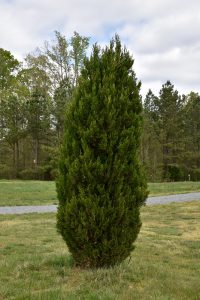
The Spartan Chinese Juniper is an evergreen tree with a growth pattern similar to the Italian Cypress. It is slender, pyramidal, and columnar.
It has tall branches and dark green foliage resembling scales and grows quickly. It provides year-round interest and a lovely vertical accent to the landscape. It works nicely as a windbreak or hedge, too.
The Spartan Chinese Juniper can grow in most well-drained soils, including clay, and is tolerant of heat, cold, salt, and drought. Since it doesn't need to be pruned, it is a low-maintenance species.
7. Eastern Red Cedar
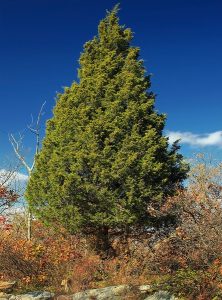
In the wild, the Eastern Red Cedar is often shaped like a shrub, but when grown, it can resemble a pyramid. A beautiful contrast to the rest of the environment is created by the foliage, which is lush and green in the summer and turns a rusty copper color in the fall but doesn't drop any leaves.
The Eastern Red Cedar will thrive in full sun, dry, rocky soils. It grows slowly, as most other junipers do. Despite being an east coast native, it is grown in Colorado below 6,000 feet as a windbreak and for its aesthetic appeal. Plant with caution as it can act as a wildfire ladder fuel and is known to cause allergies in some people.
8. One-Seed Juniper

The Southwestern states are home to the One-Seed Juniper, which is significant to the regional environment. It serves as a nursery plant and a home for animals by creating microclimates for species that can't withstand the intense sun.
It has an excellent adaptation to the arid climate. Although not a large tree, its taproot can extend 200 feet below the surface when fully grown. The dioecious One-Seed Juniper has separate male and female trees. On female trees, the cones reach maturity after about five months and are dark blue and purple. It can grow in full sun to light shade in sandy, gravelly, and loose rocky soils.
9. Concolor Fir

The Concolor Fir grows at a medium rate of around 12" each year and is evergreen. The needles are upward-pointing, 1 ½ inches long, and positioned at the branches' top side. When crushed, they release a light citrus scent and last for ten years. They are blue, green, or silver in hue. Low to the ground, the branching. It grows naturally with Colorado spruce and douglas fir in rocky parts of the high plains, typically between 3,000 and 9,000 feet above sea level in dry climates.
10. Rocky Mountain Juniper
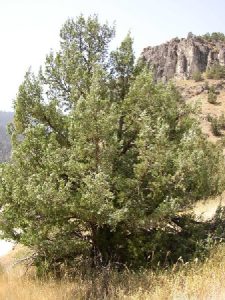
In the American West, the Rocky Mountain Juniper grows at elevations between 1,600 and 8,900 feet. It can be found in Colorado's western region, not the high Rockies. The Rocky Mountain Juniper produces two berry-like seed cones that develop after an additional year and a half and are then eaten by wildlife.
Depending on the tree, the pollen cones might be male or female. The Rocky Mountain Juniper is a long-living species that can live for up to 2,000 years and has green leaves rather than needles.
11. Cork Bark Fir
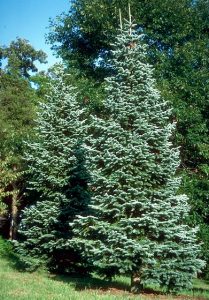
An evergreen tree native to the Western United States is the cork bark fir. Its needles are silver- gray, 1 – 1 ½ inches long, and usually point upwards. The bark is a creamy white and resembles cork, hence the common name. Young trees appear open, and as they mature, they fill out.
The Cork Bark Fir is a sturdy tree that can withstand windy conditions and significant amounts of snow. Although they require well-drained soil, they may live in dry environments as well. The Cork Bark Fir and Colorado Blue Spruce have similar shapes and colors.
12. Pinon Pine

Native to Colorado, the Pion Pine is dense and heavy in appearance, making it ideal for use as a wind or noise barrier in residential landscaping.
The Pinon Pine develops to a size that is around half that of its wild counterpart on the Front Range. It is a tree that grows slowly, adding approximately 6" each year. Both in cultivation and the wild, the Pion Pine has been observed reaching heights of up to 9,000 feet above sea level. The short, grayish-green needles are covered in the highly sought- after pine cones, which both humans and birds love.
13. Norway Spruce

The Norway spruce is an evergreen with a broad conical form and short, green needles. It has a lofty crown and drooping secondary branches, which are initially relatively inflexible and loosen up with age.
Given access to enough water, it is a tree that grows quickly. It requires more moisture than native evergreens and will probably require additional irrigation when rainfall is insufficient. Light to dark green, rigid, and acutely pointed needles are grouped around the stem. When mature, the cones are cylindrical, light brown in color, and hang from the branches. The Norway Spruce prefers sandy, acidic, damp soil that drains well.
14. Scotch Pine
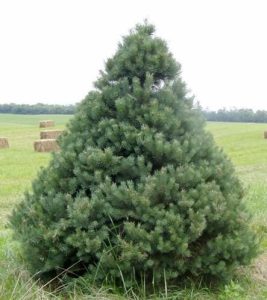
A coniferous tree known for its orange trunk is the Scotch Pine. In most cases, unless the central leader is destroyed when young, it is straight-trunked. When young, it has a pyramidal shape, which broadens with maturity.
Because it can withstand a wide range of varied climatic and biological circumstances, including poor soils, drought, and frost, the Scotch Pine is the most widely distributed worldwide. The Scotch Pine is a pioneer species that can sprout in previously damaged regions. It will not, however, put up with air pollution.
15. Ponderosa Pine
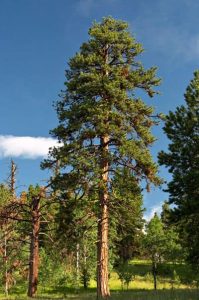
Another native tree to Colorado that may reach elevations of 10,000 feet is the ponderosa pine. It is a fast-growing tree with thick bark that serves as a windbreak and fire resistance. The Ponderosa Pine features long blue-green needles 1 ½ – 3 inches long, open branches, and dense secondary branching. It tends to lose its bottom branches and take on a somewhat rounded shape.
The Ponderosa Pine is a huge tree that grows best in xeric environments and should only be placed in spaces where it can grow to its full size. It can be spotted in the wild with its roots in bare rocks and cracks. It will grow in a variety of soil types.
What is the fastest-growing evergreen tree in Colorado?
The fastest-growing spruce, the Norway spruce, grows roughly 3' a year. Large yards benefit significantly from its spread of 25–30 feet and height of up to 40–60 feet at full maturity.

